Smoking beef belly is a simple yet rewarding culinary adventure that yields incredibly flavorful and tender results. With just a few steps, you can enjoy a mouthwatering dish that will impress your family and friends.
In this article, I will guide you through the process of smoking beef belly, from selecting and seasoning the meat to slow cooking it to perfection. Get ready to indulge in the deliciousness of beef belly!
Key Takeaways:
- Smoking beef belly is an easy recipe that produces tender and flavorful results.
- Select and season the beef belly with kosher salt, black pepper, garlic powder, onion powder, and paprika.
- Prepare your smoker and maintain a temperature of 225°F while smoking the beef belly.
- Cook the beef belly in a disposable aluminum pan with beef broth for added moisture and tenderness.
- Baste the beef belly with a mixture of apple cider vinegar, brown sugar, honey, Worcestershire sauce, and mustard for extra flavor.
- Let the beef belly rest before slicing and serving, and explore various ways to enjoy it, such as in sandwiches, nachos, loaded fries, chili, or alongside BBQ sides.
Selecting and Seasoning the Beef Belly
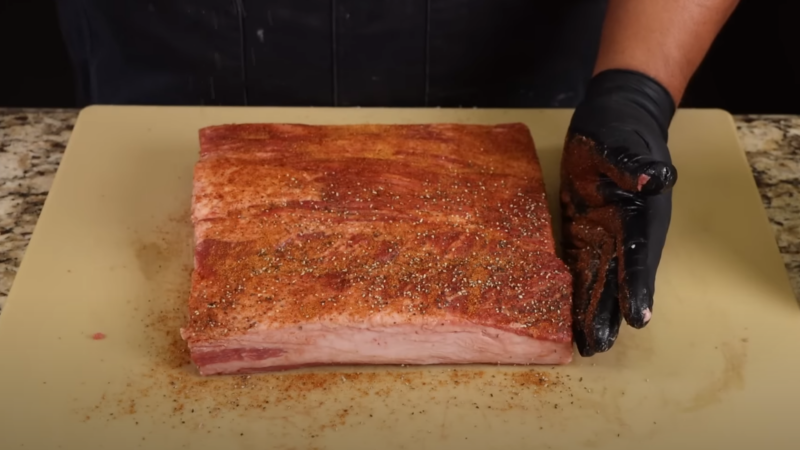
The key to a delicious smoked beef belly starts with selecting a high-quality piece of meat and seasoning it generously with kosher salt, black pepper, garlic powder, onion powder, and paprika. These flavorful seasonings will create a mouthwatering crust on the beef belly as it smokes, enhancing its taste and aroma.
When choosing a beef belly, look for one that has a good balance of meat and fat. The marbling of fat throughout the meat will ensure that it stays tender and moist during the smoking process. You can ask your local butcher to assist you in finding the perfect cut or look for it at a specialty meat store.
Once you have your beef belly, gently pat it dry with paper towels to remove any excess moisture. This will help the seasonings adhere to the surface of the meat. In a small bowl, combine kosher salt, black pepper, garlic powder, onion powder, and paprika. Sprinkle this seasoning mixture evenly over the entire beef belly, making sure to coat all sides.
| Ingredients for Seasoning: |
|---|
| – 2 tablespoons kosher salt |
| – 1 tablespoon black pepper |
| – 1 tablespoon garlic powder |
| – 1 tablespoon onion powder |
| – 1 tablespoon paprika |
Summarize:
The key to a delicious smoked beef belly starts with selecting a high-quality piece of meat and seasoning it generously with kosher salt, black pepper, garlic powder, onion powder, and paprika. When choosing the beef belly, look for a well-marbled cut. Pat the meat dry before applying the seasoning mixture on all sides. Ensure an even coating to enhance the flavor and texture of the final dish.
Preparing the Smoker and Smoking the Beef Belly
Before smoking the beef belly, it’s crucial to prepare your smoker by setting it to a temperature of 225°F and ensuring a steady flow of flavorful wood chips. The smoker’s temperature is essential to achieving tender and juicy results. Maintaining a consistent heat of 225°F will allow the beef belly to slowly cook, resulting in a melt-in-your-mouth texture.
When it comes to wood chips, choose ones that complement the rich flavor of beef. Hickory, mesquite, or applewood are popular choices that infuse the meat with a smoky aroma. Soak the wood chips in water for about 30 minutes before using them in the smoker. This will prevent them from burning too quickly and create a steady smoke flow while cooking the beef belly.
The Steps to Prepare the Smoker:
- Ensure that the smoker is clean and free from any residue from previous use.
- Fill the water pan with hot water to create a moist cooking environment.
- Place the soaked wood chips in the smoker box or directly on the heat source.
- Light the smoker and allow it to preheat to the desired temperature of 225°F.
- Once the smoker has reached the correct temperature, it’s time to begin smoking the beef belly.
By following these steps, you’ll be well on your way to creating a mouthwatering smoked beef belly that will impress your family and friends. The preparation of the smoker is just as crucial as the cooking process itself, so take the time to ensure that everything is set up correctly before proceeding.
| Smoker Preparation Checklist | Status |
|---|---|
| Smoker is clean and free from residue | ✓ |
| Water pan is filled with hot water | ✓ |
| Wood chips are soaked in water | ✓ |
| Smoker is preheating to 225°F | ✓ |
With the smoker prepared and the beef belly seasoned, it’s time to move on to the next step – smoking the beef belly to perfection. The slow and steady cooking process will result in a tender and flavorful dish that will have everyone asking for seconds.
Slow Cooking the Beef Belly
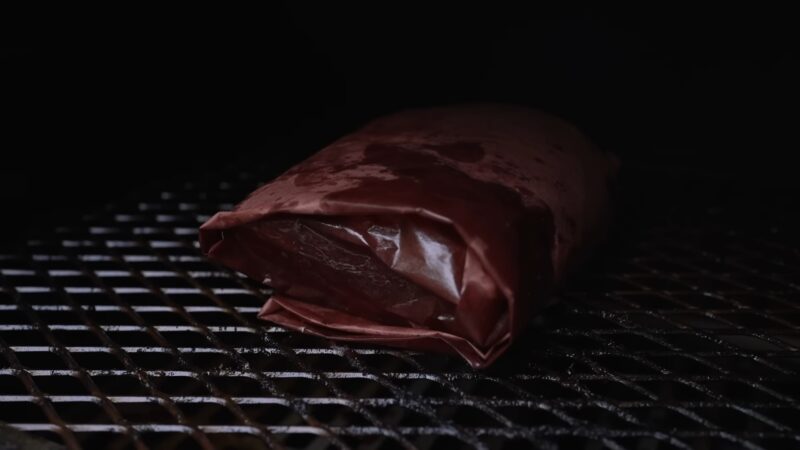
Once the beef belly has been smoked, it’s time to transfer it to a disposable aluminum pan, pour beef broth into the pan, and continue slow cooking until it reaches an internal temperature of 190°F. Slow cooking is a crucial step to achieve tenderness and enhance the flavors of the beef belly. The combination of the smoky notes from the smoking process and the richness of the beef broth will create a mouthwatering dish that is sure to impress.
When slow cooking, it’s important to cover the pan tightly with foil to trap in the heat and ensure even cooking. This will help tenderize the meat and infuse it with the flavors of the beef broth. The long cooking time allows the collagen in the beef belly to break down, resulting in a melt-in-your-mouth texture that is incredibly satisfying.
During the slow cooking process, it’s advisable to periodically check the internal temperature of the beef belly using a meat thermometer. The desired internal temperature for a perfectly cooked beef belly is 190°F. This temperature ensures that the meat is fully cooked and tender, allowing it to easily pull apart with a fork. Keep in mind that cooking times may vary, so it’s important to use the internal temperature as a guide to determine when the beef belly is done.
| Slow Cooking Tips |
|---|
| 1. Cover the pan tightly with foil to retain heat and moisture. |
| 2. Check the internal temperature regularly using a meat thermometer. |
| 3. Allow the beef belly to rest for at least 30 minutes before slicing and serving. |
Once the beef belly has reached the desired internal temperature, remove it from the oven and let it rest for at least 30 minutes. This resting period allows the juices to redistribute throughout the meat, resulting in a juicier and more flavorful final product. After the resting period, slice the beef belly against the grain to ensure maximum tenderness. Serve it as the centerpiece of a meal or use it as a versatile ingredient in various dishes. The slow-cooked beef belly pairs perfectly with a wide range of accompaniments, such as sandwiches, nachos, loaded fries, chili, and BBQ sides.
Experiment with different wood chips to add subtle nuances of flavor to the beef belly, or alternatively, if you don’t have a smoker, you can slow-cook the beef belly in the oven. The key is to adjust the cooking time and temperature accordingly to achieve the desired results. Regardless of the method you choose, the end result will be a tender, succulent, and flavorful beef belly that is sure to impress your family and friends.
Basting for Moisture and Flavor
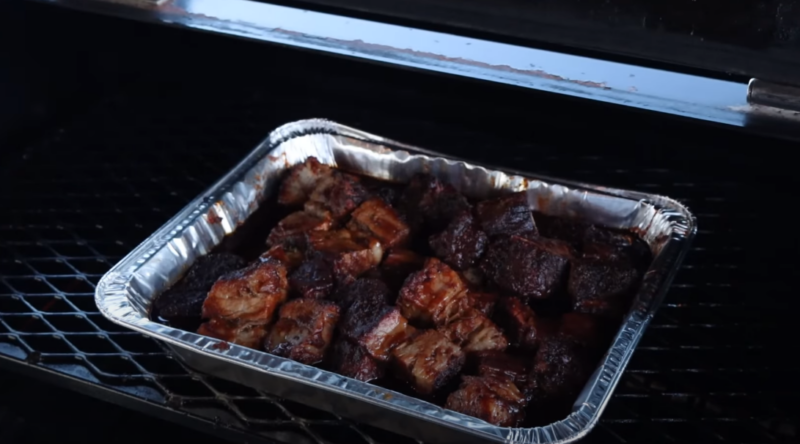
To keep the beef belly moist and amplify its flavor, a mouthwatering basting mixture of apple cider vinegar, brown sugar, honey, Worcestershire sauce, and mustard is applied throughout the cooking process.
During the slow cooking of the beef belly, regular basting with this delectable mixture helps to infuse the meat with a tantalizing combination of tangy, sweet, and savory flavors. The apple cider vinegar adds a pleasant acidity, while the brown sugar and honey bring a touch of sweetness. The Worcestershire sauce contributes depth and richness, and the mustard adds gentle heat and complexity to the overall taste profile.
The basting process not only adds moisture to the beef belly but also helps to form a caramelized crust on the outside, enhancing both the texture and flavor of the meat. As you baste the beef belly, the mixture seeps into the meat, imparting its delicious flavors and creating a beautiful glaze on the surface.
Recipe for Basting Mixture
| Ingredients | Measurements |
|---|---|
| Apple cider vinegar | 1/4 cup |
| Brown sugar | 2 tablespoons |
| Honey | 2 tablespoons |
| Worcestershire sauce | 1 tablespoon |
| Mustard | 1 tablespoon |
To prepare the basting mixture, simply combine all the ingredients in a bowl and whisk until well blended. Once the beef belly is in the smoker and you begin the cooking process, brush the basting mixture onto the meat every hour, ensuring that it is evenly coated. This frequent basting ensures that the beef belly remains juicy and succulent, with each bite bursting with incredible flavor.
Resting and Serving the Beef Belly
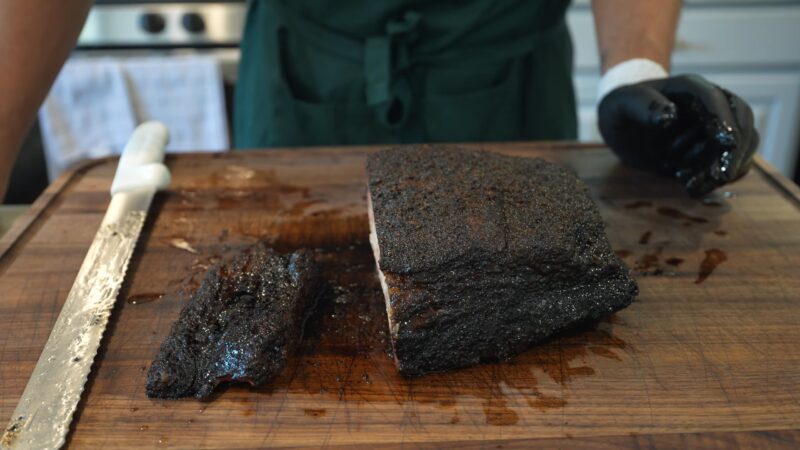
After the slow cooking process, it’s essential to let the beef belly rest for at least 30 minutes to allow the flavors to settle before slicing and serving it in various mouthwatering ways. This resting period allows the juices to redistribute throughout the meat, resulting in a more tender and flavorful dish. Whether you choose to serve the beef belly on its own or incorporate it into other dishes, the rest time is crucial for achieving the best possible outcome.
During the resting period, cover the beef belly loosely with foil to retain heat and moisture. This resting technique also allows the meat to become more firm and easier to slice. Slicing the beef belly too soon can cause the juices to run out, resulting in a less juicy and less appealing dish. Patience is key when it comes to letting the beef belly rest, as the rewards of a properly rested piece of meat are well worth the wait.
Once the beef belly has sufficiently rested, it’s time to unleash your creativity and enjoy it in various ways. One popular option is serving the beef belly on a sandwich. Layer thinly sliced beef belly on a soft roll or bread of your choice, and add your favorite toppings and condiments for a delicious and satisfying meal. Another tasty option is using the smoked beef belly as a topping for nachos or loaded fries. The smoky, savory flavors of the beef belly pair perfectly with the cheesy and crispy goodness of these indulgent snacks.
If you’re in the mood for something heartier, consider incorporating the beef belly into a beef belly chili. The tender and flavorful meat will add depth and richness to the chili, creating a comforting and satisfying dish. You can also serve the smoked beef belly alongside classic BBQ sides such as coleslaw, baked beans, or cornbread for a barbecue feast. The versatility of the beef belly allows you to explore a wide range of culinary possibilities and customize your meal to suit your taste preferences.
Tips and Variations
For those looking to elevate their beef belly smoking game, here are some handy tips and variations, from trying different wood chips to utilizing the oven for slow cooking.
If you want to experiment with different flavors, consider using different wood chips when smoking your beef belly. Hickory chips will give your meat a strong and robust flavor, while applewood chips will add a subtle and slightly sweet taste. Mesquite chips are ideal for those who enjoy a smokier profile. Feel free to mix and match to create your own unique flavor combination.
If you don’t have a smoker or prefer to use your oven, you can still achieve fantastic results with your beef belly. Simply preheat your oven to 225°F and place the seasoned beef belly in a roasting pan. Add a cup of water or beef broth to the pan to keep the meat moist. Cover the pan tightly with foil and slow cook the beef belly for 6-8 hours, or until it reaches an internal temperature of 190°F. The result will be tender and flavorful, just like when using a smoker.
Looking to add a twist to your basting mixture? Try adding a dash of hot sauce or a squeeze of citrus juice for an extra kick. You can even experiment with different types of mustard or swap the Worcestershire sauce for soy sauce to give your beef belly a unique flavor profile. Don’t be afraid to get creative with your basting ingredients to suit your personal taste preferences.
With these tips and variations, you can take your beef belly smoking to the next level. Whether you’re trying different wood chips or utilizing your oven, the result will be a tender, flavorful, and delicious dish that is sure to impress.
| Tips | Variations |
|---|---|
| Try different wood chips to experiment with flavors | Add hot sauce or citrus juice to your basting mixture for a kick |
| Utilize your oven for slow cooking if you don’t have a smoker | Swap Worcestershire sauce for soy sauce for a different flavor profile |
Pairing the Beef Belly
The delectable and versatile smoked beef belly can be paired with various dishes, such as sandwiches, nachos, loaded fries, beef belly chili, or simply enjoyed alongside your favorite BBQ sides. The rich smoky flavor and tender texture of the beef belly make it a perfect ingredient to elevate and enhance these classic dishes.
If you’re looking for a handheld delight, why not create a mouthwatering sandwich? Thinly slice the smoked beef belly and layer it between two slices of crusty bread. Add some creamy horseradish sauce, crisp lettuce, and tangy pickles for an explosion of flavors and textures.
For a crowd-pleasing appetizer, top a pile of crispy tortilla chips with generous amounts of the smoked beef belly. Melt some cheese over the top and sprinkle on diced tomatoes, green onions, and jalapenos for a zesty kick. Finish it off with a dollop of sour cream and a drizzle of barbecue sauce to complete the ultimate plate of loaded nachos.
If you’re in the mood for some indulgence, create loaded fries with a twist. Cut thick potato wedges and bake them until golden and crispy. Layer the smoked beef belly on top and smother it with cheese sauce, crispy bacon bits, and a sprinkle of green onions. This hearty dish will satisfy all your cravings.
Beef Belly Chili
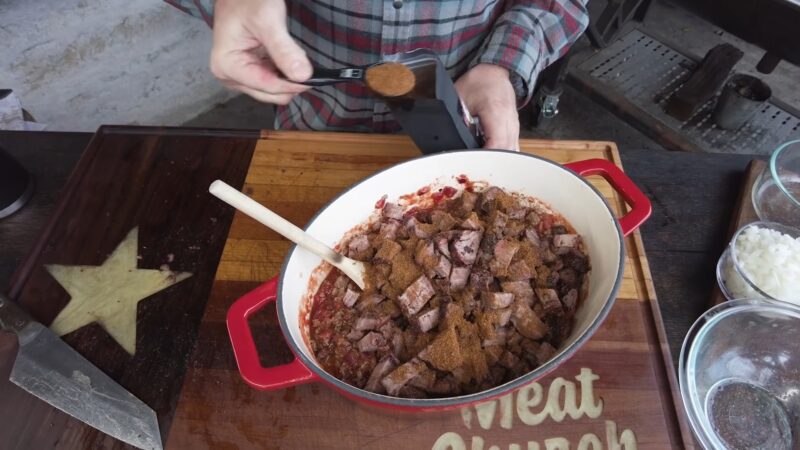
Take your chili game to the next level by incorporating the smoked beef belly. Chop the smoked beef belly into small chunks and add it to your favorite chili recipe. Allow it to simmer for hours, allowing the flavors to meld together and infuse the chili with a smoky richness. Serve the beef belly chili with some cornbread or over rice for a satisfying and comforting meal.
Lastly, the smoked beef belly is an excellent companion to your favorite BBQ sides. Whether it’s creamy coleslaw, tangy baked beans, or smoky mac and cheese, the beef belly will add an extra layer of flavor and elevate your side dishes to new heights.
There are endless possibilities when it comes to pairing the versatile beef belly. Its tender and flavorful nature makes it a standout ingredient that will wow your taste buds. So go ahead, get creative, and enjoy the delightful experience of pairing the delicious smoked beef belly with your favorite dishes!
FAQ
What is beef belly?
A beef belly is a cut of beef that comes from the underside of the cow. It is known for its rich marbling and tenderness, making it ideal for smoking.
Where can I find beef belly?
You can typically find beef belly at specialty butcher shops or online meat suppliers. It may also be available at high-end grocery stores or through local farmers.
Can I use a different type of seasoning for the beef belly?
Yes, you can experiment with different seasonings based on your personal preference. However, the suggested combination of kosher salt, black pepper, garlic powder, onion powder, and paprika provides a well-rounded flavor profile.
Do I need a smoker to smoke beef belly?
While a smoker is traditionally used to smoke beef belly, you can also achieve similar results by slow-cooking it in the oven. Simply adjust the cooking time and temperature accordingly.
How long should I let the beef belly rest before serving?
It is recommended to let the beef belly rest for at least 30 minutes before slicing and serving. This allows the juices to redistribute and the meat to become more tender.
Can I freeze the leftover smoked beef belly?
Yes, you can freeze the leftover smoked beef belly for future use. Wrap it tightly in plastic wrap or place it in an airtight container before freezing. Thaw it in the refrigerator before reheating.
Final Words
Source Links
